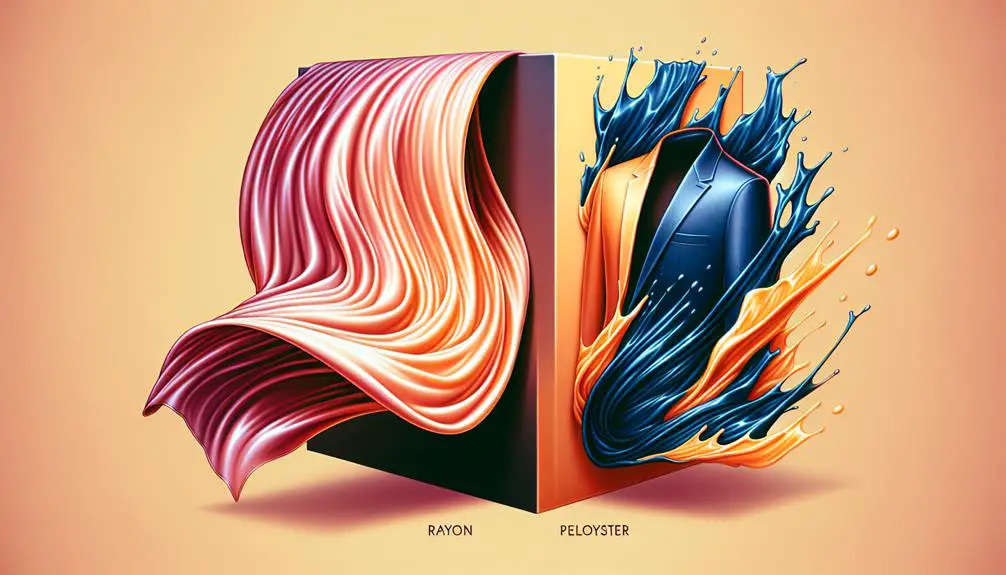I've been mulling over whether rayon or polyester takes the crown for the best fabric, and honestly, it's not a straightforward answer. If you're leaning towards something with a soft touch and a bit of luxury, rayon might be your go-to. But, if durability and ease of care are more your vibe, then polyester could be the winner. Each has its perks and pitfalls, and it really boils down to what you're looking for in a fabric. So, let's unpack this a bit further, shall we? I think you'll find the nuances between the two quite intriguing.
Table of Contents
Key Takeaways
- Rayon offers a softer, more luxurious feel suitable for fashion and comfort-focused garments.
- Polyester excels in durability, making it ideal for active wear and items subjected to frequent washing.
- Rayon is more breathable and moisture-absorbent, better for warm climates or sensitive skin.
- Polyester has superior moisture-wicking and resistance properties, making it better for sports apparel and outdoor gear.
- The choice between rayon and polyester depends on the specific needs: comfort and breathability vs. durability and moisture management.
Understanding Rayon Fabric
Rayon's a semi-synthetic fabric that feels soft and silky, making it a go-to for comfy yet stylish summer outfits. It's crafted from regenerated cellulose, which basically means it combines the best of both natural and synthetic worlds. This fabric's got a natural luster and a subtle sheen to it, kinda like silk, but without making your wallet weep. What's really cool about rayon is how it's breathable and lightweight, perfect for those flowy dresses and breezy shirts that are essential when the heat cranks up.
It's also a champ at absorbing moisture, keeping you cool and dry when it's sweltering outside. Plus, rayon's easy to dye, offering a rainbow of colors to choose from for your wardrobe. And it can handle high water temperatures in the wash, so keeping it clean is a breeze. When I'm picking out what to wear or what to buy, the fabric's always a big deal for me. While polyester has its perks, there's something about the comfort and elegance of rayon that makes it stand out. It's the fabric that keeps me looking good and feeling good all summer long.
Exploring Polyester Characteristics
Now, let's talk about what makes polyester stand out.
We'll look into its durability, how it manages moisture, and its flexibility in use across different products.
It's pretty cool how this fabric can do so much, from surviving rough wear to keeping you dry.
Polyester Durability Analysis
Looking into polyester's characteristics, it's clear this material stands out for its incredible durability. Its tensile strength is something to brag about, making it a go-to for anything that needs to hold up under pressure.
We're talking heavy-duty applications where you can't afford a tear or a wear too soon. And let's not forget about its abrasion resistance. Polyester doesn't just give up when it rubs up against rough surfaces or harsh conditions.
This resilience extends to fighting off mildew and shrugging off most chemicals too. Whether it's gear for the great outdoors, workwear that takes a beating, or just your everyday items that go through the wash a million times, polyester's durability makes it a reliable choice.
Moisture Management Properties
Polyester steps up the game with its moisture management properties, making it a powerhouse in keeping you dry and comfortable. It's not just about staying dry; it's about feeling good while you're at it. Let's dive into what makes polyester stand out:
- Moisture-wicking properties: Ensures sweat moves away from your body, keeping you dry during intense workouts.
- Moisture-resistant: Unlike other fabrics, polyester doesn't absorb moisture, making it perfect for rainy days or sweaty gym sessions.
- Synthetic advantage: Its synthetic nature allows it to repel water, setting it apart in performance wear.
- Ideal for activewear: Polyester's ability to manage moisture makes it a top choice for sports apparel, where staying dry equals staying comfortable.
Versatility in Applications
One can't overlook polyester's knack for versatility, making it a star in various applications from stylish apparel to rugged outdoor gear. When we're talking polyester vs. any other fabric, its ability to be used to make everything from comfy home furnishings to durable industrial fabrics really puts it in a league of its own. Its resistance to wrinkles and color fading primes it for items that need to last and look good doing it.
Plus, its moisture-wicking and quick-drying traits are why it's the go-to for sportswear. Easy to care for and maintaining shape like a champ, it's often mixed with other fibers to up its game even more.
The versatility in applications of polyester isn't just impressive; it's practically essential in our fabric arsenal.
Rayon Vs Polyester Durability
When it comes to durability, polyester outshines rayon because it's tougher and can handle more wear and tear. If you're anything like me, you want clothes that last longer than a season, and for that, durability is key. You don't want to toss out a favorite shirt just because it couldn't stand up to your lifestyle. So, let's dive into why polyester might be your go-to fabric for durability:
- Tensile Strength: Polyester's strength is unmatched compared to rayon. It takes a lot to break or deform, meaning your outfits keep their shape and integrity longer.
- Resistance to Tearing: Ever caught your clothes on something and held your breath? Polyester significantly reduces those mini heart attacks by being less prone to tearing.
- Frequent Washing: Polyester can endure regular washes without falling apart. This is crucial for anyone who's not into hand-washing or gentle cycles.
- Long-lasting Performance: For items that need to withstand a lot, polyester is the champion. It keeps up with your demands without compromising on appearance or functionality.
In the battle of durability, polyester clearly wins. It's the material that'll stick around, proving its worth time and time again.
Comfort and Breathability Analysis
Shifting gears to comfort and breathability, it's clear that rayon takes the lead over polyester in keeping you cool and comfortable. Here's the scoop: rayon is way more breathable and moisture-absorbent than polyester. This means when the mercury rises, rayon's your best bet. It lets your skin breathe, allows heat to escape, and sucks up any sweat, making it a go-to for those scorching summer days.
On the flip side, polyester is kind of a letdown in the breathability department. It's not great at letting air through or absorbing moisture, which can be a bummer if you're wearing it for a long stretch. It traps heat and can make you feel like you're wrapped in plastic wrap. Not exactly what you want when you're trying to stay cool.
But here's where it gets interesting: polyester has its moments in cooler weather. It's less breathable, sure, but this makes it warmer than rayon when the temperature drops. So, while rayon is the champion of summer comfort, polyester isn't completely out of the race—it's just more of a winter warrior.
Maintenance and Care Requirements
Let's talk about how to keep our rayon and polyester garments looking their best.
I'll guide you through the dos and don'ts of washing instructions, drying techniques, and the right ironing temperatures.
It's all about striking the perfect balance between ease and care to make our clothes last longer.
Washing Instructions
Caring for rayon and polyester requires different approaches, especially when it comes to washing and drying. Rayon, with its smooth texture, needs delicate care to keep it looking its best. Hand washing in cold water is a must to prevent any shrinking or stretching that could ruin its shape.
On the flip side, polyester's robust nature means it can withstand machine washing in warm water without batting an eye.
- Rayon: Hand wash in cold water for delicate care.
- Polyester: Machine wash in warm water, resilient to life's tumbles.
- Stretching and Shrinking: Polyester wins with its resistance.
- Maintenance: Polyester is low maintenance, while rayon requires a bit more love.
Each fabric has its own set of rules to live by, ensuring they stay in prime condition.
Drying Techniques
When it comes to drying, rayon and polyester have their own needs to keep them looking great.
For rayon, air-drying is the way to go. It's all about avoiding shrinkage and keeping that soft feel. Tossing it in the dryer with high heat? That's a no-go because rayon doesn't take kindly to heat damage.
Now, polyester is a different story. It's pretty chill with heat, so you can tumble dry it on low without worrying about it getting wrecked. But, regardless of whether you're dealing with rayon or polyester, sticking to the care instructions is key. It ensures your clothes don't just survive the wash but come out looking as good as new.
Ironing Temperatures
Navigating the ironing game, rayon and polyester each play by their own rules to avoid becoming a crinkled mess. Since rayon is made from natural fibers, it doesn't take kindly to high heat. You gotta treat it gently, ironing at low to medium temps to avoid a disaster. Polyester, on the other hand, is made to withstand harsh treatment. It laughs in the face of high heat, making wrinkle removal a breeze.
- Rayon needs a soft touch with low to medium heat.
- Polyester can handle the heat, from moderate to high settings.
Always check the garment care labels; they're your best buds. Rayon's sensitivity to heat means a cooler iron setting is key.
Mastering these fabrics means playing by their rules, and trust me, your clothes will thank you.
Environmental Impact Assessment
Assessing the environmental impact of textiles, it's clear that rayon's natural origins make it a greener choice over polyester. When we dive into the environmental impact assessment, the comparison between natural fibers like rayon and synthetic fiber such as polyester, sheds light on some significant differences. Rayon, being derived from natural cellulose fibers, inherently has a leg up on eco-friendliness. It's because its production doesn't lean heavily on fossil fuels, which is a big win for the planet.
On the flip side, polyester is a whole different story. It's a synthetic fiber that comes from petroleum-based products. This not only screams non-renewable but also highlights a process riddled with environmental concerns. Manufacturing polyester is notorious for releasing a hefty amount of greenhouse gases and pollutants. It's kind of like giving the environment a one-two punch that it definitely doesn't need.
Choosing rayon isn't just about picking a fabric; it's about making a statement to reduce our carbon footprint and lessen the environmental impact. So, in the battle of textiles, if we're talking green, rayon's natural charm certainly gives it a solid edge over polyester.
Cost Comparison
Typically, you'll find polyester is cheaper than rayon, thanks to its synthetic roots. When I'm out shopping for fabrics, whether for my own projects or recommending materials to friends, cost comparison always comes up. Polyester's lower price point isn't just about being less expensive; it's about understanding what you're getting for your money.
- Polyester's synthetic production makes it a budget-friendly option, often used in a wide range of applications.
- Rayon, though more expensive, offers a different value, derived from its semi-synthetic nature and the more intricate manufacturing process.
- The cost of rayon is bumped up due to its production from natural sources like wood pulp, which can be a deal-breaker for some.
- When it's about sticking to a budget without sacrificing too much on quality, polyester often wins out.
I've learned that while the allure of rayon's semi-synthetic charm is undeniable, polyester's appeal lies in its practicality and affordability. It's a constant balancing act between cost and quality, but knowing these points makes it easier to make an informed decision.
Final Recommendations
When deciding between rayon and polyester, it's crucial to weigh the specific needs of your project. Here's the lowdown: if you're aiming for that smooth, luxurious feel, especially for something like decorative embroidery, rayon's your go-to. It's made from wood pulp, which gives it that natural luster and softness that's hard to beat. But, if we're talking about items that'll go through the wringer—think commercial use or anything that'll be washed a ton—polyester pulls ahead for its toughness and vibrant colors.
| Feature | Rayon | Polyester |
|---|---|---|
| Softness | High, smooth, luxurious | Lower than rayon |
| Durability | Lower, sensitive to moisture | High, bleach resistant |
| Colorfastness | Good, but fades over time | Excellent, vibrant |
| Special Features | Made from wood pulp, natural sheen | Elasticity, withstands harsh chemicals |
In a nutshell, the differences between rayon and polyester boil down to what you need from your material. Rayon shines in the softness and aesthetic department, perfect for those high-end looks. Polyester, on the other hand, is your workhorse, ready for whatever life throws at it. Pick wisely based on your project's demands!
Frequently Asked Questions
Is Rayon Better Quality Than Polyester?
I'd say rayon's superior due to its natural softness and breathability. It feels luxurious and drapes well, making it comfy for various climates. Polyester's durable but can't match rayon's quality and comfort.
What Fabric Is Better Than Rayon?
I'd say polyester tops rayon in many aspects. It's more durable, wrinkle-resistant, and retains its shape better. Especially for outdoor gear or sports apparel, polyester's the go-to for its longevity and resilience.
Does Rayon Breathe More Than Polyester?
I've learned that rayon definitely breathes more than polyester. It's because rayon's made from natural fibers, allowing better air circulation and moisture escape, making it a winner for comfort in warmer or more humid conditions.
What Are the Pros and Cons of Rayon Fabric?
I've found that rayon's pros include its softness, breathability, and moisture absorption, making it comfy in hot weather. However, it's prone to shrinking, tears, and requires gentle care, lacking the durability of some alternatives.
- Recycling Nonwoven Fabrics: Is It Possible? - July 11, 2025
- Recycling Nonwoven Fabrics: Is It Possible? - July 11, 2025
- Recycling Nonwoven Fabrics: Is It Possible? - July 11, 2025





